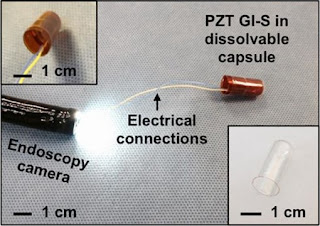FLEXIBLE SENSORS CAN DETECT MOVEMENT OF FOOD I
Prof Dr,DRAM,HIV /AIDS,HEPATITIS ,SEX DISEASES & WEAKNESS expert,New Delhi,India, +917838059592
esearchers at MIT and Brigham and Women's Hospital have built a flexible sensor that can be rolled up and swallowed. Upon ingestion, the sensor adheres to the stomach wall or intestinal lining, where it can measure the rhythmic contractions of the digestive tract.Such sensors could help doctors to diagnose gastrointestinal disorders that slow down the passage of food through the digestive tract. They could also be used to detect food pressing on the stomach, helping doctors to monitor food intake by patients being treated for obesity.
The flexible devices are based on piezoelectric materials, which generate a current and voltage when they are mechanically deformed. They also incorporate polymers with elasticity similar to that of human skin/ mucosa , so that they can conform to the skin / mucosa and stretch when the skin / mucosa stretches.
Traverso and colleagues have previously developed ingestible devices that can be used to monitor vital signs or deliver drugs to the digestive tract. With the goal of developing a more flexible sensor that might offer improved safety, Traverso teamed up with Dagdeviren, who previously developed flexible electronic devices such as a wearable blood pressure sensor and flexible mechanical energy harvesters.
To make the new sensor, Dagdeviren first fabricates electronic circuits on a silicon wafer. The circuits contain two electrodes: a gold electrode placed atop a piezolelectric material called PZT, and a platinum electrode on the underside of the PZT. Once the circuit is fabricated, it can be removed from the silicon wafer and printed onto a flexible polymer called polyimide.
The ingestible sensor that the researchers designed for this study is 2 by 2.5 centimeters and can be rolled up and placed in a capsule that dissolves after being swallowed.This type of sensor could make it easier to diagnose digestive disorders that impair motility of the digestive tract, which can result in difficulty swallowing, nausea, gas, or constipation.Doctors could also use it to help measure the food intake of patients being treated for obesity.
- Kidney stones universally present hazard in north india,dillution by water prevent it
- Steroid and placebo effect equally for mild persisting asthma with low sputum eosinophils
- Government wants to fix public healthcare staff shortages with ayush docs: will it work?
- Plea in hc for payment of salaries of edmc, north mcd teachers and doctors
- 7 indian pharma companies named in us lawsuit over inflating generic drug prices
- Woman in up dies after explosion in her mouth during treatment,what is diagnosis?
- Woman in up dies after explosion in her mouth during treatment,what is diagnosis?
- Woman in up dies after explosion in her mouth during treatment,what is diagnosis?
- Air pollution ! mothers organising rally in london,anaesthetist choosing gas,will india follow?
- Cardiac arrest is always not sudden as understood -a study


 Comments (
Comments ( Category (
Category ( Views (
Views (